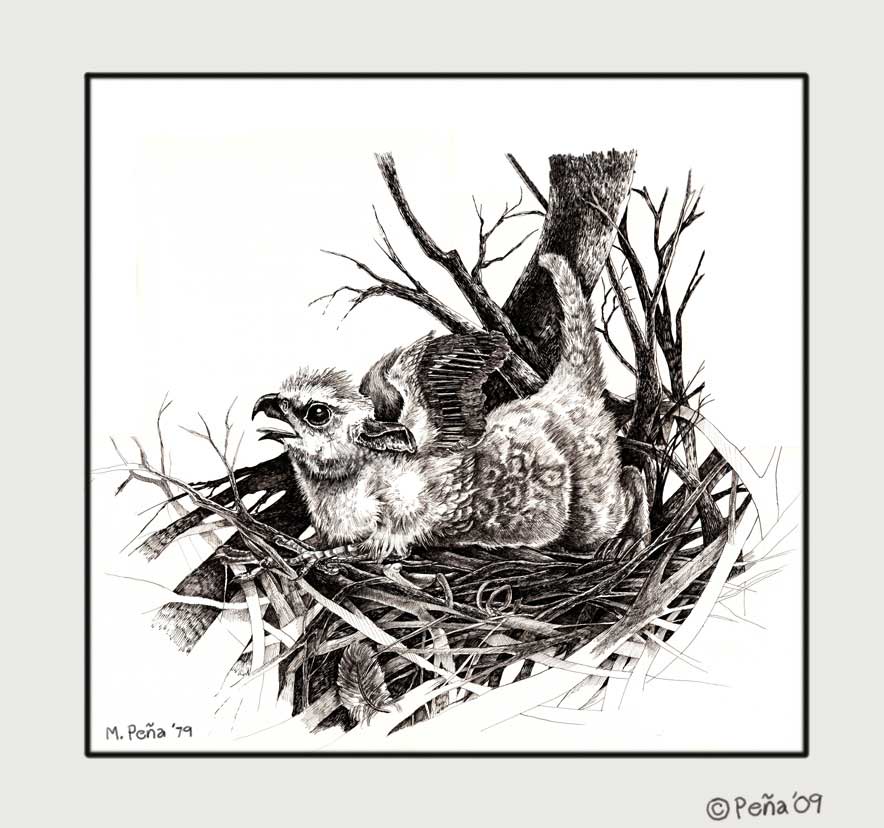
Ouch.
More fun with fantasy animals.
In addition to coming up with convincing BS anatomy for them, you also get to invent their whole natural history!
I did this drawing of a hatchling griffin about thirty years ago, and started working on the problems about how they have babies. I took the easy way out and assumed that they are hatched from eggs in nests and were fed the way eagles feed their young, but with horse guts instead of ground squirrels . Did you know that griffins eat horses?
There are some fantasy creatures that have pretty strange reproductive methods. The Cockatrice hatches from a black egg laid by a rooster, and brooded by a toad. Good thing that doesn’t happen often. Minotaur had a human mother and I assume was delivered normally, but gad, I hope the father was one of the small headed breeds of cattle.
Phoenixes hatch themselves, that is really weird. That’s the ultimate inbreeding.
But what about all the other fantasy creatures? What does a pregnant mermaid look like? How do the babies get OUT? Does the mother develop a dark “gravid spot” like guppies do?
What does a pregnant centaur look like? Which uterus is the baby carried in?
What does a pregnant thestral look like?
Have any thoughts on this subject?

I imagine centaur anatomy to be crazy. They’d need a pretty good set of lungs… what if the human torso was nothing but a good set of lungs, and mammaries for the ladies. Everything else is carried by the equine body, including the digestive tract. I’d bet that grazing would be difficult, so maybe they adapted to browse higher up than grasses… like leaves, etc. What do they eat anyway? Is there text on this anywhere?
Can you imagine mouth-breeder mermaids, like african cichlids? Dad opens his mouth and 300 tiny baby mermaids swim out. Creepy. I like it.
I bet gryphons have non-functional, vestigial nipples.
So that explains why Ariel and her sisters didn’t have a mother in the “Little Mermaid”. The father did the brooding?
OH! Perhaps the fathers have the sea horse’s brood pouch?
Perhaps griffins have nipples… until their first litter…
Hippocampi have the pouch. I still think mermaids are mouth breeders.
I’m making this all up. It’s fun.
I picture merfolk reproducing the way other sea mammals do, but I kind of like the idea that the fathers do the seahorse thing and raise the young. It would also explain why the mermen are seldom seen, but the mermaids have all that time to sit around on rocks, tempting sailors. I would like to go a little further and wonder if, maybe, there is a 3-step plan? Human male impregnates mermaid, mermaid passes the “joey” to a merman, who finishes off the gestation and rearing? Might make an interesting SF/F story.
I vote “YES” on griffins having live births and nipples. The grifflings’ beaks could be a blunt, leathery snout that hardens later into the actual beak. Weaning for them would come the same way it does for many mammals: “Ouch! Okay, kid, if you can draw blood, it’s time for SOLIDS!”
Thestrals could be live birth or hatched, or something far more magical. Something involving the last breath a person exhales at death, a mother’s tears of grief, and the light of a full moon, spun together with a drop of blood from the would-be parent thestrals.
Centaurs have a human-like upper body and a horse-like lower body, but that doesn’t mean they are a horse and a human stuck together! After all, gorillas are human-like and a moose is horse-like, but only if you have no better way to describe them. It’s rather like the old story of the 3 blind men trying to describe an elephant. It all depends on your point of reference. That being said, I see them reproducing in a fairly straightforward, equine manner, with no “human”…parts… involved. It would be handy if the mammary glands were fully functioning. It would prevent the kid from getting a serious crick in it’s neck while nursing as it gets older… unless the head structure is really different from human!
Oh, the things one could come up with. Unfortunately, I’m not all that clever.